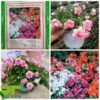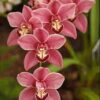# A Comprehensive Guide to Cleaning Dendrobium Orchid Leaves

Dendrobium orchids are a popular choice among orchid enthusiasts due to their stunning blooms and unique growth habits. However, to keep these beautiful plants thriving, it’s essential to maintain their overall health and appearance. One crucial aspect of orchid care is cleaning the leaves, which can help improve photosynthesis, prevent pest infestations, and enhance the aesthetic appeal of the plant. In this comprehensive guide, we will explore the importance of cleaning Dendrobium orchid leaves, the best techniques for doing so, and tips for ensuring your plants remain healthy and vibrant.
## 1. Importance of Cleaning Dendrobium Orchid Leaves
### 1.1 Enhancing Photosynthesis
Leaves are vital for the process of photosynthesis, where plants convert sunlight into energy. Dust, dirt, and residues can accumulate on the leaves, blocking sunlight and reducing the plant’s ability to photosynthesize effectively. Regularly cleaning the leaves allows for maximum light absorption, promoting healthier growth and more abundant blooms.
### 1.2 Preventing Pest Infestations
Dust and debris on leaves can attract pests like aphids, mealybugs, and spider mites. These pests can cause significant damage to your Dendrobium orchids if not addressed promptly. By keeping the leaves clean, you can minimize the chances of pest infestations and the diseases they may carry.
### 1.3 Improving Aesthetic Appeal
Clean, shiny leaves enhance the overall beauty of your Dendrobium orchids. A well-maintained plant not only looks more attractive but also indicates that it is receiving proper care. This aesthetic quality is especially important if you are displaying your orchids at home or at exhibitions.
## 2. When to Clean Dendrobium Orchid Leaves
### 2.1 Frequency of Cleaning
The frequency with which you clean your Dendrobium orchid leaves will depend on your growing environment. Generally, it is advisable to clean the leaves every two to four weeks. However, consider the following factors:
– **Indoor vs. Outdoor**: Orchids grown indoors may accumulate dust more slowly than those outdoors, where wind and rain can introduce dirt and debris.
– **Seasons**: During warmer months, when plants are actively growing, you may need to clean the leaves more frequently due to increased dust and sap production.
– **Presence of Pests**: If you notice signs of pests or sticky residues on the leaves, it’s essential to clean them immediately.
### 2.2 Signs That Cleaning is Needed
Watch for the following signs that indicate your Dendrobium orchids may need a cleaning:
– **Dust Accumulation**: If the leaves appear dull or dusty, it’s time for a cleaning.
– **Sticky Residue**: A sticky film on the leaves may indicate the presence of pests, such as aphids or mealybugs, and should be addressed promptly.
– **Yellowing Leaves**: While yellowing can be caused by various factors, excessive dust can sometimes contribute to this issue.
## 3. Tools and Materials Needed for Cleaning
Before you begin cleaning your Dendrobium orchid leaves, gather the necessary tools and materials:
### 3.1 Basic Cleaning Supplies
– **Soft Cloth or Sponge**: A soft, lint-free cloth or sponge is ideal for cleaning the leaves without scratching them.
– **Water**: Use distilled or filtered water to avoid mineral deposits that can occur with tap water.
– **Mild Soap Solution (Optional)**: If the leaves are particularly dirty or sticky, a mild soap solution can be helpful. Use a few drops of liquid dish soap mixed with water.
– **Spray Bottle**: A spray bottle makes it easy to apply water or cleaning solutions to the leaves.
### 3.2 Optional Supplies for Extra Care
– **Leaf Shine Products**: While not necessary, some orchid enthusiasts prefer to use commercial leaf shine products to enhance the glossiness of the leaves.
– **Cotton Swabs**: Useful for cleaning hard-to-reach areas or for more delicate cleaning tasks.
## 4. Step-by-Step Guide to Cleaning Dendrobium Orchid Leaves
### 4.1 Preparation
1. **Choose the Right Time**: Clean your orchids in the morning or early evening when temperatures are cooler to avoid stress on the plant.
2. **Inspect Your Plants**: Before cleaning, check for any signs of pests, disease, or damage. Address any issues you find.
3. **Gather Your Tools**: Ensure you have all your cleaning supplies ready.
### 4.2 Cleaning Process
#### Step 1: Water Rinse
1. **Fill the Spray Bottle**: Fill your spray bottle with distilled or filtered water.
2. **Mist the Leaves**: Lightly mist the leaves with water. This helps to loosen any dirt and dust without over-saturating them.
#### Step 2: Wipe the Leaves
1. **Dampen the Cloth**: Take your soft cloth or sponge and dampen it with water (or a mild soap solution, if needed).
2. **Wipe Gently**: Starting from the base of the leaf, wipe gently towards the tip. Use a soft touch to avoid damaging the leaves.
3. **Check Both Sides**: Make sure to clean both the upper and lower sides of each leaf, as dust can accumulate on both surfaces.
4. **Focus on Stubborn Spots**: For sticky residues or stubborn dirt, you may need to apply a little more pressure, but do so carefully.
#### Step 3: Rinse and Dry
1. **Rinse with Water**: After wiping down the leaves, give them a light misting of clean water to remove any soap residue, if used.
2. **Dry the Leaves**: Allow the leaves to air dry. Ensure they are completely dry before placing them back in direct sunlight to prevent leaf burn.
### 4.3 Special Considerations
– **Avoid Cleaning During Flowering**: If your Dendrobium orchids are in bloom, avoid cleaning the flowers directly. Instead, focus on the leaves and pot area to prevent damage to the delicate blooms.
– **Check for Signs of Stress**: After cleaning, monitor your orchids for any signs of stress, such as drooping leaves or color changes. This can help you identify if your cleaning method was too harsh.
## 5. Additional Tips for Maintaining Healthy Leaves
### 5.1 Environmental Factors
– **Humidity**: Maintain humidity levels between 50% and 70% to prevent leaf desiccation and promote overall plant health.
– **Air Circulation**: Ensure good air circulation around your orchids to reduce the likelihood of fungal infections and pests.
### 5.2 Fertilization
– **Balanced Fertilizer**: Use a balanced fertilizer during the growing season to support healthy leaf growth.
– **Avoid Over-Fertilization**: Excessive fertilizer can lead to leaf burn and unhealthy growth.
### 5.3 Monitoring for Pests
– **Regular Inspections**: Check your Dendrobium orchids regularly for signs of pests, such as webs or sticky residues.
– **Use Natural Remedies**: If pests are detected, consider using insecticidal soap or neem oil as a natural remedy.
## 6. Troubleshooting Common Issues
### 6.1 Brown Leaf Tips
– **Causes**: This can result from low humidity, underwatering, or salt buildup from fertilizer.
– **Solutions**: Ensure adequate humidity levels and water regularly, and flush the potting medium with distilled water to remove salts.
### 6.2 Yellowing Leaves
– **Causes**: Yellow leaves can indicate overwatering, underwatering, or nutrient deficiencies.
– **Solutions**: Assess your watering routine and adjust as necessary, and consider fertilizing with a balanced orchid fertilizer.
## 7. Conclusion
Cleaning the leaves of Dendrobium orchids is a vital aspect of their care, enhancing their beauty, promoting healthy growth, and preventing pest infestations. By following the steps outlined in this guide, you can ensure your orchids remain in optimal condition. Remember to monitor your plants regularly and address any issues that arise promptly. With proper care, your Dendrobium orchids will continue to thrive and produce stunning blooms that bring joy and beauty to your home or garden. Happy orchid growing!

